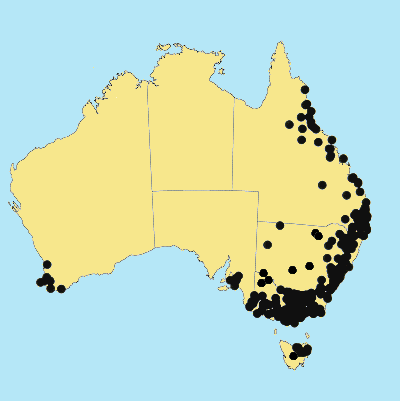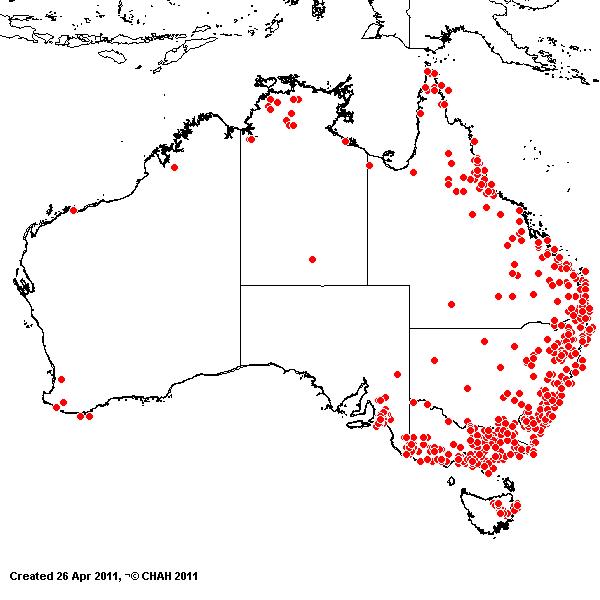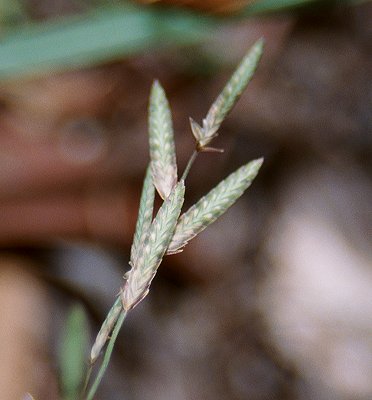Eragrostis brownii (Kunth) Nees. Nomen. Bot. ed. 2, 1: 562 (1840).
Classification. (GPWG 2001) : Subfamily Chloridoideae. Cynodonteae.
Basionym and/or Replacement Name: Poa brownii Kunth, Revis. Gramin. 1: 112 (1829), based on Poa polymorpha R.Br. (1812), non Wibel (1799).
Type of Basionym or Protologue Information: T): R. Brown 6284, 20 Oct 1803, Australia: "Inter australiense", Shoal water Bay (K-(H79/39 1x); IT: US-2191491 (fragm. ex K-(H79/39 1x) & Photo)). T (alpha) LT designated by Lazarides, Austral. Syst. Bot. 10: 101 (1997).
Recent synonyms: E. benthamii, E. brownii var. patens, E. philippica, E.rara.
Key references (books and floras): [1810]. R.Brown, Prodromus (180 as Poa polymorpha), [1878] G.Bentham, Flora Australiensis 7 (646), [1952] C.A.Gardner, Flora of Western Australia 1 Gramineae (119), [1969] E.E.Henty, Manual Grasses New Guinea (92), [2002] D.Sharp & B.K.Simon, AusGrass, Grasses of Australia, [2002] J.Wheeler, N.Marchant & M.Lewington, Flora of the South West (416), [2006] J.Jessop, G.R.M.Dashorst, F.M.James, Grasses of South Australia (365), [2008] S.W.L.Jacobs, R.D.B.Walley & D.J.B.Wheeler, Grasses of New South Wales (249 as E. benthamii).
Illustrations: [1952] C.A.Gardner, Flora of Western Australia 1 Gramineae (120, Pl. 34), [2005] K.Mallet (ed.), Flora of Australia 44B: Poaceae 3 (Fig. 70A-D), [2006] J.Jessop, G.R.M.Dashorst, F.M.James, Grasses of South Australia (365, Fig. 293), [2008] S.W.L.Jacobs, R.D.B.Whalley & D.J.B.Wheeler, Grasses of New South Wales, 4th edn (249 as E. benthamiana & 250).
Habit. Perennial. Culms erect or geniculately ascending, stature slender to delicate, 11–60 cm tall. Ligule a fringed membrane or a fringe of hairs, a ciliolate membrane, 0.1–0.3 mm long. Leaf-blades straight, flat or involute or convolute, 10–25 cm long, 1–3 mm wide.
Inflorescence. Inflorescence compound, a panicle. Panicle ovate, 5–30 cm long, contracted about primary branches.
Spikelets. Spikelets sessile or pedicelled. Fertile spikelets many flowered, with at least 2 fertile florets (8–24), comprising 8–24 fertile floret(s), with diminished florets at the apex, linear or elliptic or oblong or ovate, laterally compressed, 4–12.5 mm long.
Glumes. Glumes similar. Lower glume ovate, membranous, keeled, 1-keeled, 1 -nerved. Upper glume ovate, 1.5–2.8 mm long, membranous, keeled, 1-keeled, 1 -nerved.
Florets. Fertile lemma 1.7–3 mm long, keeled, 3 -nerved. Lemma apex muticous. Anthers 2–3. Grain 0.7 mm long.
Continental Distribution: Tropical Asia, Australasia, and Pacific.
Australian Distribution: Western Australia, South Australia, Queensland, New South Wales, Victoria, Tasmania, Norfolk I (*).
Western Australia: Dale, Menzies, Warren. South Australia: Northern Lofty, Murray, Southern Lofty, South-eastern. Queensland: Cook, North Kennedy, South Kennedy, Port Curtis, Leichhardt, Burnett, Wide Bay, Darling Downs, Moreton, Maranoa. New South Wales: North Coast, Central Coast, South Coast, Northern Tablelands, Central Tablelands, Southern Tablelands, North-Western Slopes, Central-Western Slopes, South-Western Slopes, North-Western Plains, South-Western Plains, North Far Western Plains, South Far Western Plains. Victoria: East Gippsland, Eastern Highlands, Gippsland Highlands, Gippsland Plain, Grampians, Lowan Mallee, Midlands, Murray Mallee, Otway Plain, Otway Range, Wilsons Promontory, Riverina, Snowfields, Volcanic Plain, Wannon, Wimmera. Tasmania: North East, Midlands, East Coast.
Notes. Eragrostis brownii is considered here to be a widely distributed Australian native. In the past, the species was widely misapplied to the Asiatic and S American species, E. nutans, E. subsecunda, E. bahiensis and E. spartinoides, by prominent agrostologists such as Trinius, Nees and Steudel. Bentham's concept included ten species. Eragrostis brownii is a polymorphic highly variable species belonging to a closely related group of intergrading species including E. elongata and E. sororia.
Native; occurs in SW corner of W.A., around Adelaide and Mt. Gambier, S.A., and common in eastern Australia from about Cairns inQld S to St. Marys in Tas.; also occurs in New Zealand, Polynesia and Easter Island. In sandy, red earth, loamy, solodic or podsolic soils;.often on skeletal and stony or gravelly hillslopes, ridges and outcrops of sandstone, laterite, granite and shale; seasonal swamps, depressions, marshes, and low-lying sand plains; alluvial flats; coastal sandhills and flats; sandy clearings in woodland and forest, rail enclosures and other disturbed ground; roadside weed.; flowers in all months; fruits in all months.








